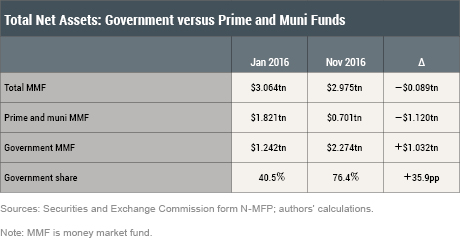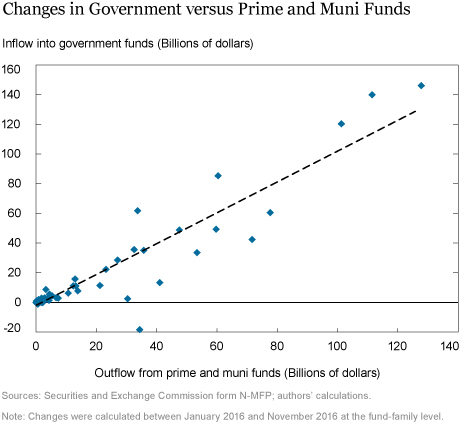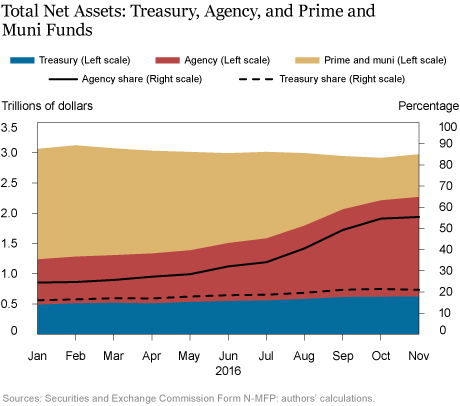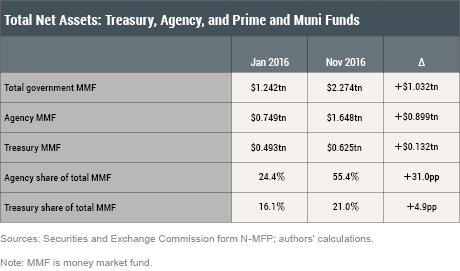On October 14, 2016, amendments to Securities and Exchange Commission (SEC) rule 2a-7, which governs money market mutual funds (MMFs), went into effect. The changes are designed to reduce MMFs’ susceptibility to destabilizing runs and contain two principal requirements. First, institutional prime and muni funds—but not retail or government funds—must now compute their net asset values (NAVs) using market-based factors, thereby abandoning the fixed NAV that had been a hallmark of the MMF industry. Second, all prime and muni funds must adopt a system of gates and fees on redemptions, which can be imposed under certain stress scenarios. This post studies the effect of the amendments on the size and composition of the MMF industry and, in particular, whether MMF investors shifted their assets from prime and muni funds toward government funds in anticipation of the tighter regulatory regime.
Shift to Government Funds
Using month-end data from public regulatory filings by MMFs from January to November 2016 (the SEC Form N-MFP), we show that the relative size of prime and muni versus government funds has changed dramatically even as overall total net assets (TNA) of the industry have been roughly stable. Indeed, as the chart and table below show, TNA in the prime and muni segment of the MMF industry have fallen by more than half, with TNA declining $1.120 trillion, whereas those in the government segment have increased by $1.032 trillion; as a result, the share of overall TNA invested in government funds has soared in the space of ten months, from 41 percent to 76 percent.


Shifts within or across Fund Families?
Given the large shifts into government funds from prime and muni funds, it’s interesting to understand whether investors chose to keep their assets within their original family of funds; understanding this sheds light on whether the reforms had a meaningful impact on the overall assets of individual fund complexes. Although it is difficult to track where exact flows come from and go within the MMF industry, the data suggest that investors largely remained within their chosen fund complex. Each data point in the chart below represents one fund family; on the horizontal axis, we have the outflow from prime and muni funds in the family, whereas on the vertical axis we have the inflow into government funds. For most fund complexes, the outflow from prime and muni funds matches almost one for one the inflow into government funds; indeed, a regression of the inflow to government funds on the outflow from prime and muni funds gives a coefficient of almost exactly one (1.04).

Shifts to Higher-Yield Government Funds
Investors in the prime and muni segment of the MMF industry are likely to have a higher appetite for yield and a higher tolerance for risk than government MMF investors. One may expect that, given their risk preferences, those investors who moved their assets to government funds would concentrate on the segment of the government fund industry that provides a higher yield. The data support this hypothesis.
There are two types of government funds: agency funds, investing in Treasuries, agency debt, and repos backed by these securities, and Treasury funds, investing only in Treasuries and Treasury repos. Historically, agency funds have delivered higher yields; for instance, since November 2010 when the SEC started collecting the N‑MFP data, the average yield on agency funds has exceeded that for Treasury funds by 7 basis points.
As the chart and table below show, the Treasury share of the MMF industry has remained roughly flat; in contrast, the share of agency MMFs has increased from 24.4 percent of the overall industry to 55.4 percent. In other words, investors have moved to the segment of the government MMF industry that is closer (in terms of yield) to the prime and muni segment. They have likely done so in order to avoid the potential for liquidity gates and fees, and in the case of institutional investors, to keep the desirable feature of a fixed NAV, while at the same time maximizing the yield from their MMF investment.


Summing Up
Overall, investors’ shift from prime and muni funds to government—and, in particular, agency—funds means that a large segment of the industry still operates under a stable NAV (and therefore is, in principle, vulnerable to runs). Yet, financial institutions tend to suffer runs when their investments have gone, or are perceived to have gone, sour (as was the case in 2008, after Lehman Brothers’ bankruptcy); indeed, government funds, which invest in safer assets than prime funds, did not experience any run in 2008. Since the new regulations have resulted in a very large shift of assets into relatively safe government funds, the SEC’s reforms have made runs on MMFs less likely and the industry itself more resilient.
Disclaimer
The views expressed in this post are those of the authors and do not necessarily reflect the position of the Federal Reserve Bank of New York or the Federal Reserve System. Any errors or omissions are the responsibility of the authors.
Catherine Chen is a former policy and market analysis associate in the Federal Reserve Bank of New York’s Markets Group.

Marco Cipriani is a research officer in the Bank’s Research and Statistics Group.

Gabriele La Spada is an economist in the Bank’s Research and Statistics Group.

Philip Mulder is a senior research associate in the Bank’s Research and Statistics Group.

Neha Shah is a policy and market analysis associate in the Bank’s Markets Group.
How to cite this blog post:
Catherine Chen, Marco Cipriani, Gabriele La Spada, Philip Mulder, and Neha Shah, “Money Market Funds and the New SEC Regulation,” Federal Reserve Bank of New York Liberty Street Economics (blog), March 20, 2017, http://libertystreeteconomics.newyorkfed.org/2017/03/money-market-funds-and-the-new-sec-regulation.html.











 RSS Feed
RSS Feed Follow Liberty Street Economics
Follow Liberty Street Economics